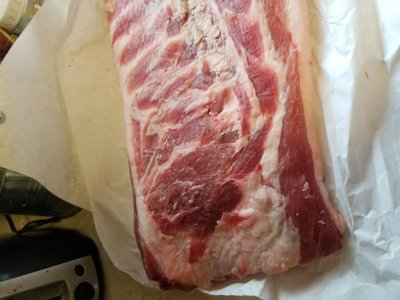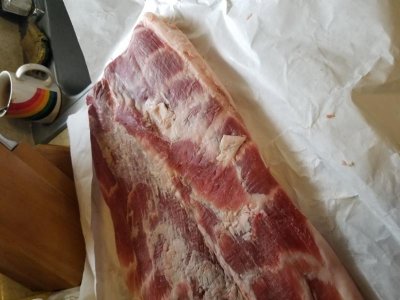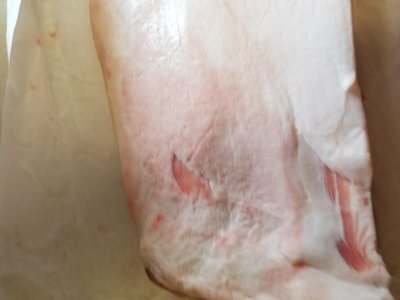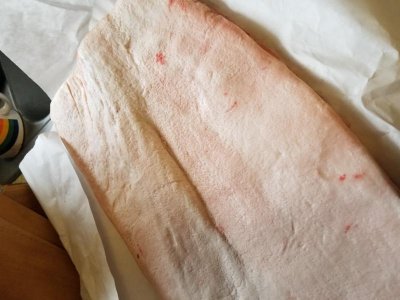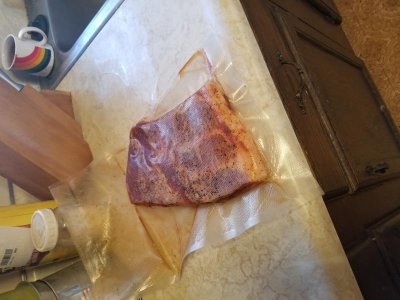-
working on DNS.. links may break temporarily.
You are using an out of date browser. It may not display this or other websites correctly.
You should upgrade or use an alternative browser.
You should upgrade or use an alternative browser.
Making Bacon
- Thread starter brdbbq
- Start date
Lomey
is one Smokin' Farker
Good luck! Update during the process.
IamMadMan
somebody shut me the fark up.
Keep us posted....
brdbbq
Quintessential Chatty Farker
2-3 LBS pork Belly
1/2 Cup Sugar (cane, Brown or coconut )
1 tbs Honey,or Maple syrup or Agave Nectar
2 tsb Sea Salt
2 tsp Smoked Paprika
1 tsp curing salt (pink salt) Prague #1
1 tsp Coarse Black Pepper
1 tsp White Pepper
1-2 tbs Apple Juice
Sriracha Lime infusion
Apply to belly vac seal marinate 7 days massage daily. Rinse then smoke till 150* IT. put in fridge for a day slice fry enjoy.
My first time and no condom....:drama:
1/2 Cup Sugar (cane, Brown or coconut )
1 tbs Honey,or Maple syrup or Agave Nectar
2 tsb Sea Salt
2 tsp Smoked Paprika
1 tsp curing salt (pink salt) Prague #1
1 tsp Coarse Black Pepper
1 tsp White Pepper
1-2 tbs Apple Juice
Sriracha Lime infusion
Apply to belly vac seal marinate 7 days massage daily. Rinse then smoke till 150* IT. put in fridge for a day slice fry enjoy.
My first time and no condom....:drama:
IamMadMan
somebody shut me the fark up.
2-3 LBS pork Belly
1/2 Cup Sugar (cane, Brown or coconut )
1 tbs Honey,or Maple syrup or Agave Nectar
2 tsb Sea Salt
2 tsp Smoked Paprika
1 tsp curing salt (pink salt) Prague #1
1 tsp Coarse Black Pepper
1 tsp White Pepper
1-2 tbs Apple Juice
Sriracha Lime infusion
Apply to belly vac seal marinate 7 days massage daily. Rinse then smoke till 150* IT. put in fridge for a day slice fry enjoy.
My first time and no condom....:drama:
I'm not finding fault with your bacon recipe, but if I were following this recipe for myself, I would have concerns about the amount of Cure #1 used. A single teaspoon of cure #1 is enough to cure 5 pounds of meat, you reference 2-3 pounds giving an average of 2.5 pounds of meat. Thus according to your post you are using twice the amount of cure required.
I would also be concerned with the amount of sugar vs the amount of salt at a 4.5 parts sugar to 1 part salt ratio (9 tablespoons of sugars vs 2 tablespoons of salt).
Salt is necessary to cure the meat. Salt helps to pull the moisture from the cells and dissolves the salt mixture and them distributes it back into the cell structure of the meat. So having the proper amount of salt is also critical.
While sugar is used to cut the sharpness of the salt in a cure, but your recipe is basically almost all sugar when compared to the other ingredients. Keep in mind that a lot of sugar can interfere with salt absorption and slow down the curing process.
I also highly advocate the use of a scale to weigh your ingredients according to the weight of the meat.
When curing, the items should be weighed (not measured) for accuracy, consistency, and food safety. Using the metric mode is much more accurate.
When making bacon use the following dry-cure ratios...
Cure #1 - the ratio is 0.25% (Multiplier .0025)
Salt - the ratio is 3% (Multiplier .03)
Sugar - the ratio is 1.25% (Multiplier .0125)
Weigh the pork belly in grams, record the weight and multiply using the above Multiplier to get the exact ratio for each ingredient.
Last edited:
brdbbq
Quintessential Chatty Farker
I'm not finding fault with your bacon recipe, but if I were following this recipe for myself, I would have concerns about the amount of Cure #1 used. A single teaspoon of cure #1 is enough to cure 5 pounds of meat, you reference 2-3 pounds giving an average of 2.5 pounds of meat. Thus according to your post you are using twice the amount of cure required.
I would also be concerned with the amount of sugar vs the amount of salt at a 4.5 parts sugar to 1 part salt ratio (9 tablespoons of sugars vs 2 tablespoons of salt).
Salt is necessary to cure the meat. Salt helps to pull the moisture from the cells and dissolves the salt mixture and them distributes it back into the cell structure of the meat. So having the proper amount of salt is also critical.
While sugar is used to cut the sharpness of the salt in a cure, but your recipe is basically almost all sugar when compared to the other ingredients.
I also highly advocate the use of a scale to weigh your ingredients according to the weight of the meat.
When curing, the items should be weighed (not measured) for accuracy, consistency, and food safety. Using the metric mode is much more accurate.
When making bacon use the following dry-cure ratios...
Cure #1 - the ratio is 0.25% (Multiplier .0025)
Salt - the ratio is 3% (Multiplier .03)
Sugar - the ratio is 1.25% (Multiplier .0125)
Weigh the pork belly in grams, record the weight and multiply using the above Multiplier to get the exact ratio for each ingredient.
That's why I posted it. I read the prague powder label after reading the recipe. Things didn't add up. And total agree on metric scale. More Better
I could be wrong but I've always understood that using Cure#1 when hot smoking bacon is used to retain a nice red color and not necessary for the curing of the meat.
That said, the ratios that MadMan posted are what I use myself.
That said, the ratios that MadMan posted are what I use myself.
Kimo1
Full Fledged Farker
Second on too much Prague #1. With 2.5# of belly you would only need 0.5 tsp (2.4 grams) which will give you around 125 ppm (100 being minimum and 200 maximum). Also, if the belly is an inch thick you should only need to cure 1.5 - 2.5 days. If it's 2 inches thick 5 - 7 days.
Last edited:
brdbbq
Quintessential Chatty Farker
Second on too much Prague #1. With 2.5# of belly you would only need 0.5 tsp (2.4 grams) which will give you around 125 ppm (100 being minimum and 200 maximum). Also, if the belly is an inch thick you should only need to cure 1.5 - 2.5 days. If it's 2 inches thick 5 - 7 days.
How do you it has cured enough ?
Jrogers84
is Blowin Smoke!
How do you it has cured enough ?
Day per 1/4 inch from the middle.
HumboldtSmokeBBQ
is one Smokin' Farker
Wow, I seriously learned alot in 10 posts on this thread.
airedale
is one Smokin' Farker
You are wrong, actually.I could be wrong but I've always understood that using Cure#1 when hot smoking bacon is used to retain a nice red color and not necessary for the curing of the meat. ...
Be a little careful with that. First, it assumes that the cure is diffusing from both sides of the meat. That will not be the case if there is skin on one side.Day per 1/4 inch from the middle.
Also, it doesn't always work. I recently had a piece of "picnic" pork that was about 2 1/2" inches thick with both sides exposed and after 11 days I still found a little uncured meat in the center. The 1/4" rule would have predicted that 5 days was adequate. I'm not sure what happened but I do know that curing the meat longer has no downside, while being in a hurry does. I typically do 7-9 days for pork bellies with both sides exposed and have never had a problem.
IamMadMan
somebody shut me the fark up.
I could be wrong but I've always understood that using Cure#1 when hot smoking bacon is used to retain a nice red color and not necessary for the curing of the meat.
That said, the ratios that MadMan posted are what I use myself.
I know many areas of Europe have unsmoked bacon (IE UK - Rashers, Germany - Bauchspeck, durchwachsener, Schinkenspeck) and is used for flavor in cooking.
After a recent trip to Europe, I realize your food purity laws are also something we could only wish for here in the US. It's a shame what we as American consumers have settled for. However the reason for the cure is two-fold...
1) Because of the extend time in refrigeration (7-10 days) cure #1 is used to prevent spoilage. Our store bought meats are trucked across country from processor, to warehouse, and then to store distribution, and our meat products are not as fresh as yours.
2) Because when smoking bacon, we usually smoke at a lower temperature gradually raising the smoker temperature over time to reach the finishing temperature of the bacon. The time in the smoker would allow the meat to be in the "danger zone" for 4 hours or more. I cold smoke my bacon for a minimum of 6 hours before applying heat, and many of us never exceed an IT of 125°.
.
Last edited:
bonz50
Take a breath!
great thread!!!!! I've been wanting to do my own bacon for some time but I lack facilities and size for the process, but that is coming soon.
brdbbq
Quintessential Chatty Farker
Day per 1/4 inch from the middle.
Measure vac packed or free state ? Kidding :becky:
VanderLaan
Well-known member
Wow, I seriously learned alot in 10 posts on this thread.
You and me, both.
Just butchered a hog and making bacon with the belly and jowls is on my to-do list. Is there a seminal thread on making bacon? Something akin to the UDS thread? If so, could someone point me to it?
brdbbq
Quintessential Chatty Farker
MisterChrister
Quintessential Chatty Farker
.... Is there a seminal thread on making bacon? Something akin to the UDS thread? If so, could someone point me to it?
This is my post from previous threads, just copied and pasted here. Ignore the part about it being for buckboard bacon (and how to cut the shoulder for buckboard, etc), and the rest is completely the same for belly bacon.
HERE'S A WRITE-UP I DID FOR ANOTHER FELLA, JUST COPIED/PASTED HERE:
For your first bacon, I'd recommend starting with buckboard bacon (just pork butt). It's a cheap way to break the ice and build confidence! The taste is identical, and you end up with a 3:1 meat to fat ratio instead of the inverse with belly. Don't get me wrong, I LOVE fatty belly bacon, but I find a lot of pleasure in the thrift of curing and sausage making, and buckboard yields much better at roughly 1/3 of the cost! Occasionally, you'll read a comment that buckboard tastes more hammy than bacony, but those folks 1) didn't smoke long enough, and usually tried smoking it as one big hunk; or 2) Warm smoked instead of cold smoking it which provides a much more robust smokey bacon flavor. Cold smoking is THE way to go for bacon in my not so humble opinion! Your smoking method and the following meat cutting step will take care of that.
Instead of curing a whole thick gnarly butt, I butterfly them open and cut in half while removing the bone. Here's how:
http://www.smokingmeatforums.com/a/b...uckboard-bacon (except go ahead and separate the two halves completely). This way you end up with 2 slabs that are roughly the thickness of regular belly bacon for more even curing and better smoke penetration. An average 10# butt will yield 2 pieces at appx 4.4# after bone loss and slight "squaring" cuts. Make sure to remove the gray stinky gland meat from the edge of the butt, most meat packers don't. Stinky butt gland, HA!!!
I HIGHLY recommend an equilibrium dry cure. It leaves nothing to chance (i.e. ALL too common oversalting woes) the way a wet cure does, plus saves a lot of frig space. It's impossible to oversalt or under cure this way, plus in my opinion it just tastes better than a wet cured bacon. You'll need a digital meat scale (preferably that goes over 5#) and a digital jewelers scale that will read in increments of a gram for measuring the cure in the necessarily exacting amounts. You can get both on amazon for about $12-$15 each. The jewelers scale I got goes down to 0.01 grams which is more ideal with the small amounts of cure #1 than a .1g increment scale. Speaking of cure, make sure to keep it out of reach of kids and pets. It looks inviting like kool-aid/sugar mix in a bag (we called it "cocaine" and took it everywhere in our pockets as kids for our sugar fix lol, ghetto I know, it's where I grew up), but the cure is toxic when ingested in significant amounts straight from the bag.
Next, simply convert your meat weight to grams (1# = ~455g), then weigh out your salt (+/- 2.5% of your meat weight = meat grams x 0.025), your brown sugar (+/- 1% of your meat weight = meat grams x 0.01), and your cure (EXACTLY 1/4th of 1% of your meat weight = meat grams x 0.0025).
Example with your theoretical 4.4# slabs:
4.4# x 455g = 2002 grams meat weight (let's round to 2000g for easy math.
2000g x .025 = 50 grams salt (any brand plain kosher or plain non-iodized).
2000g x .01 = 20 grams brown sugar.
2000g x .0025 = 5 grams pink cure #1.
You'll weigh each of the two slabs and calculate/mix/cure separately, so it's an opportunity to play with adjusting your salt and sugar levels to find your preferred taste. Try and stay between 2%-3% salt, and .75%-1.25% brown sugar. Don't mess with the cure level, it will give you exactly 156ppm nitrite per USDA FSIS guidelines. You can also play around with adding other spices in each batch, but honestly I find that not much of the additional flavors actually penetrate the meat at the curing stage. If I want pepper bacon, I'll usually lightly oil or maple syrup paint the slabs right towards the END of the smoke (an hour or so remaining) and pepper crust it then. Some folks will oil or syrup coat it and stick spices on before smoking, BUT in my opinion, this greatly inhibits smoke absorption into the actual meat. In my experience, when this is done the smoke all sticks to the oil/syrup/spices barrier on the outside, making the exterior bitter and the interior boring.
Anywhoo, mix the 3 dry cure ingredients thoroughly in a bowl and apply it evenly to all sides of your meat inside of a 2.5 gallon ziploc (available at Walmart). Be sure all of the cure gets on the meat and into the bag. If your meat has been previously frozen or for whatever other reason doesn't look like it's wet enough to release enough liquid to dissolve all of the dry ingredients during the curing stage, you can add a LITTLE water to help get things moving along. Just make sure you add the water weight into the meat weight in grams for the purpose of calculating your cure ingredients. 1/4 cup should be more than enough, so just add 59 grams (1c H20 = 236g, 1/4c = 59g) to your meat weight when calculating. Squeeze the air out of the bag, seal it up, massage everything to spread it around equally, and place in frig for 5 days minimum, up to 10 days if your schedule is tight. I usually cure Friday night and remove from the cure the following Friday to prepare for a Saturday smoke. You'd go shorter or longer for thinner or super thick pieces, but 5-10 days is perfect for a 2"-3" thick piece of meat. An equilibrium cure can't over/under cure in this time period as it's exactly the correct amount of salt/sugar/cure that your meat can absorb based on meat weight and absorbency potential. Make SURE to gently massage the package and flip it over once a day to redistribute the fluids and cure for even curing. When it's cured, remove from the bag (the night before you'll smoke it), give a quick cold water rinse, thoroughly pat dry, and put it unwrapped on a wire rack in your frig overnight to dry the surface and form the shiny/tacky pellicle layer. This will help it absorb smoke evenly.
The next day, prep your smoker to run at very low temp (100-125 max at grate/meat level, if you can) with plenty of smoke wood chunks to provide clean, even, consistent smoke throughout a long "warm smoke". Make sure to keep your meat away from direct rising heat, so as to not cook it, you'll cook it later after you slice and pan-fry it. I've heard of some people taking their bacon to 150IT at the end of the smoke to make it edible without further cooking, but I've never tried that, it just doesn't appeal to me! I have a homemade version of a Cajun Bandit 22" kettle insert, but taller with 2 racks, that works perfect for bacon. I use an A-Maze-N Products AMNPS pellet maze resting on my sweeper fins all the way at the bottom of my kettle to generate the smoke, and a single row briquette snake method on the perimeter of the charcoal grate to generate JUST enough heat to achieve a low temp warm smoke and create a good draft. Then i hang my meat slabs from the top rack with a deflector on the bottom rack to shield the meat from rising and radiant heat. Plenty of folks successfully warm smoke bacon with just wood chunks over charcoal though, so whatever you do will work as long as you're providing consistent clean "thin blue" smoke and minimal heat to create draft. Good airflow is critical when cold/warm smoking, as a cooler smoker doesn't draft as well and can let the smoke stagnate and make your food bitter like an ashtray if you're not careful. The balancing act is having a little heat to create draft, but not so much that your food cooks before it takes on an ideal amount of smoke. Make sure to keep your smoker in the shade to help keep temps down this time of year. For bacon at cool/warm smoke temps, 8-12 hours is ideal. You'll also start to get a feel for how much smoke flavor the bacon will end up with based on the nice rich color on the meat during the middle/end of the smoking session. The nitrite in the cure will keep your meat safe for extended periods in this otherwise "danger zone". Another tip; I buy cheap bamboo skewers to put on my cooking grate to put meat on when cold smoking food that I can't hang. Just in case there's some bacteria lurking on my cooking grate and I won't be making it hot enough to kill the bacteria. Here's some good reading on cold vs hot smoking.
http://www.smokingmeatforums.com/t/1...-and-hot-smoke
When you're all done, let the meat rest at room temp to cool, then pat dry and seal it up tight in 2.5 gallon ziplocs (or vacuum sealer bags work great if you have a foodsaver) for 1-3 days in the frig to let the smoke and moisture equalize throughout the whole slabs. Then, just before slicing, pop the bags/slabs in your freezer for 30-60 minutes to firm up nice to make slicing easier. A meat slicer is ideal, but a sharp, long knife and a steady hand will do. Make sure to slice against/across the grain of the meat or it'll be chewy. Also, since shoulder is a much more worked part of the animal, buckboard bacon tends to have a LITTLE more toothiness to it. Not much, but enough that you don't want to slice it like a thick cut belly bacon, or the thick slices will be more of a chew than most people associate with bacon. Thin slicing will alleviate/eliminate that issue.
If you vacseal your portions, they'll keep good for +/- 6 months in the freezer. Otherwise, I'm thinking maybe a month or two in tight freezer wrap, but am not sure as I vacseal.
You'll notice some sections will be much fattier than others. The fatty sections will fry like normal bacon, the leaner sections will need 2-4 Tbsp of a light oil in the skillet to help get the frying action started.
IamMadMan
somebody shut me the fark up.
You and me, both.
Just butchered a hog and making bacon with the belly and jowls is on my to-do list. Is there a seminal thread on making bacon? Something akin to the UDS thread? If so, could someone point me to it?
Here is an earlier post I did with culinary students..
http://www.bbq-brethren.com/forum/showthread.php?t=246208
VanderLaan
Well-known member
Apologies to the OP for hijacking this tasty, tasty thread. Say the word and I will start a new one.

